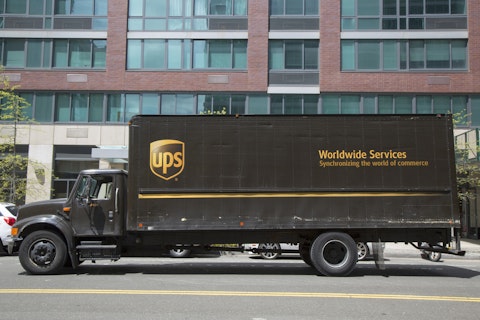
Leonard Zhukovsky / Shutterstock.com
Introduction: When Parcel Pricing Becomes a Mathematical System
Parcel shipping has entered a new era where cost is no longer determined solely by distance or weight, but by a multi-layered system of algorithms, indexed tables, dimensional formulas, and conditional rules. What appears on an invoice as “base rate + discounts + surcharges” is actually the product of dozens of interacting mathematical decisions made inside FedEx and UPS pricing engines.
This complexity explains why both carriers have achieved higher revenue per package while handling fewer packages. FedEx Ground volume fell by roughly 3% last year, yet yield increased by 6.6%. UPS reported a 7.2% decline in domestic volume, but still posted profit gains through pricing actions. The relationship between carriers and shippers is now governed more by formulas than by freight density or network efficiency.
Understanding the Math: How Base Rates Are Really Determined
Every shipment begins with a base rate taken from a carrier rate table. These tables act like grid maps, where rows and columns correspond to service level, shipping zone, and billable weight. For example, a 12-pound Ground package traveling to Zone 6 is matched against the “FedEx Ground / Zone 6 / 12 lbs” cell in the table. Whatever number appears there, say $14.89 is the starting point.
This number does not yet include discounts, minimums, fuel adjustments, or accessorial charges. It is simply the raw price “before the math.”
Zone Logic: Why Zone Errors Are More Common Than Most Realize
Carriers assign zones by referencing a matrix that compares the origin ZIP code to the destination ZIP code. These matrices are not static. When FedEx or UPS reorganize their networks, rerouting freight through different hubs/zones shift. A package that was Zone 5 last year may now be Zone 6 without any change to the ZIP codes involved.
Because these zone tables update annually and sometimes mid year, zone misassignments occur more frequently than expected. Contract modeling often reveals that a portion of shipments were billed at a higher zone than the correct one, adding several percentage points to yearly transportation spend.
DIM Weight: The Formula That Quietly Raises Billable Weight
Carriers no longer rely only on physical weight. Instead, they compute dimensional (DIM) weight by multiplying the length, width, and height of a package and dividing the total by a dimensional divisor such as 139 or 166. A 12 × 12 × 12 package has a volume of 1,728 cubic inches. Dividing that number by a 139 divisor yields 12.4 pounds, which is rounded up to 13 pounds. Even if the package physically weighs only eight pounds, the carrier charges based on the higher DIM weight.
Contract modeling regularly detects situations where the wrong divisor was applied, the physical weight should have taken precedence, or DIM rounding rules were misused. These small differences accumulate significantly at scale.
Discount Logic and Minimum Net Charge Overrides
Once the base rate is determined, the carrier applies a negotiated discount. But this discounted price is then compared to the Minimum Net Charge (MNC). If the discounted rate falls below the MNC, the discounted price is ignored and the MNC becomes the final rate.
This is a major driver of unexpected cost inflation. Industry analysis repeatedly shows that 30% to 45% of parcels default to the MNC threshold, meaning the shipper does not receive the negotiated discount at all. Contract modeling reveals this pattern by recalculating each shipment’s rate twice, once with the discount and once under the MNC rule, to determine where discounts were silently overridden.
Fuel Surcharge Indexing: Why Charges Rise Faster Than Fuel Prices
Fuel surcharges do not change in direct proportion to diesel prices. Instead, carriers use indexed tables that match diesel price ranges to specific surcharge percentages. When diesel climbs from $3.80 to $4.20, roughly a 10% increase, the Ground fuel surcharge may jump from 17.25% to 22%, which is a 27.5% increase.
This mathematical gap between fuel cost changes and surcharge indexing is why Ground fuel surcharge expenses increased more than 26% year-over-year, as highlighted by AFS Logistics’ Chief Analytics Officer, Mingshu Bates. Even when fuel remains stable, the indexed jumps may still cause sizable increases.
Accessorial Surcharge Models: Delivery Area, Oversize, and Peak Demand
Many surcharges are determined by formula or list membership rather than shipment characteristics. Delivery Area Surcharges (DAS) apply when the destination ZIP code appears on a carrier’s DAS list. UPS has expanded DAS and DAS Extended to more than 85% of U.S. ZIP codes. FedEx’s Extended DAS now applies to over 60% of rural ZIP codes.
Peak surcharges use tiered schedules based on service type, weekly volume, and time of year. Oversize surcharges combine base fees with fuel and peak multipliers, pushing some oversize charges above $125 per package. Without a modeling system, shippers cannot easily verify whether these fees were applied correctly.
Why Standard Invoice Review Fails to Detect Overbilling
Carrier invoices show only final charges, not the internal steps taken to reach them. They do not reveal:
- Which discount tier was used
- Whether the MNC threshold nullified a discount
- Whether the zone assignment was correct
- Whether DIM weight was calculated properly
- What fuel surcharge index row applied
- Whether peak demand rules were triggered appropriately
Advanced audits based on small parcel auditing reconstruct each package as if it were being priced from scratch, verifying each step in the calculation. Any discrepancy between the reconstructed rate and the invoice rate indicates a potential refund or contract misalignment.
Contract Modeling: A Complete Reconstruction of Carrier Logic
Contract modeling simulates the entire pricing process used by FedEx and UPS. The system determines the correct zone using the carrier’s zone matrix, locates the base rate from the rate table, calculates DIM weight, applies the appropriate discount, checks for MNC overrides, computes the correct fuel surcharge based on the DOE index, and applies all accessorial fees according to the carrier’s rules. If the carrier-billed amount deviates from this modeled calculation, the shipment is flagged for review.
Platforms like Hubzone Depot use this method to expose billing discrepancies and quantify savings opportunities hidden within invoice level complexity.
Financial Impact: What Modeled Data Reveals About Overspending
Data from thousands of modeled shipping accounts shows that overspending does not stem from isolated errors but from systemic mathematical interactions. Minimum Net Charge overrides are responsible for a large share of cost leakage. Fuel table discrepancies and DIM miscalculations often contribute an additional one to three percent of total spend. Zone misapplications and peak surcharges add further layers of unnoticed cost.
When aggregated, these effects produce consistent overspend levels of 12% to 22% annually for many organizations.
Beyond Parcel Shipping: Extending the Modeling Discipline to Other Costs
Companies increasingly extend this analytical discipline to broader procurement operations, uncovering savings in office supplies, industrial MRO, PPE, telecom, and specialty sourcing. Programs offering business cost-reduction services apply the same principles, reconstructing pricing logic, identifying inefficiencies, and enforcing consistent spend governance across multiple categories.
Conclusion: The Competitive Advantage Lies in Understanding the Math
FedEx and UPS have engineered pricing systems optimized for yield, not for simplicity. As indexing, dimensional formulas, dynamic surcharges, and MNC thresholds continue to evolve, shippers must adopt tools capable of replicating and verifying each mathematical step that determines the final charge.
Organizations that invest in contract modeling and invoice level reconstruction will gain a significant advantage in cost control, supplier negotiations, and overall financial performance. Those who rely solely on invoice summaries will continue paying hidden costs embedded within a pricing system built on precise mathematical design.
Parcel auditing is no longer a back office function, it is becoming one of the most sophisticated financial disciplines in modern supply chain management.
Disclaimer: The press release above isn’t produced by Insider Monkey’s editorial team. We don’t verify the contents of press releases for accuracy. It is strongly recommended that you perform due diligence before investing or trading in anything, including consulting a professional financial advisor.





